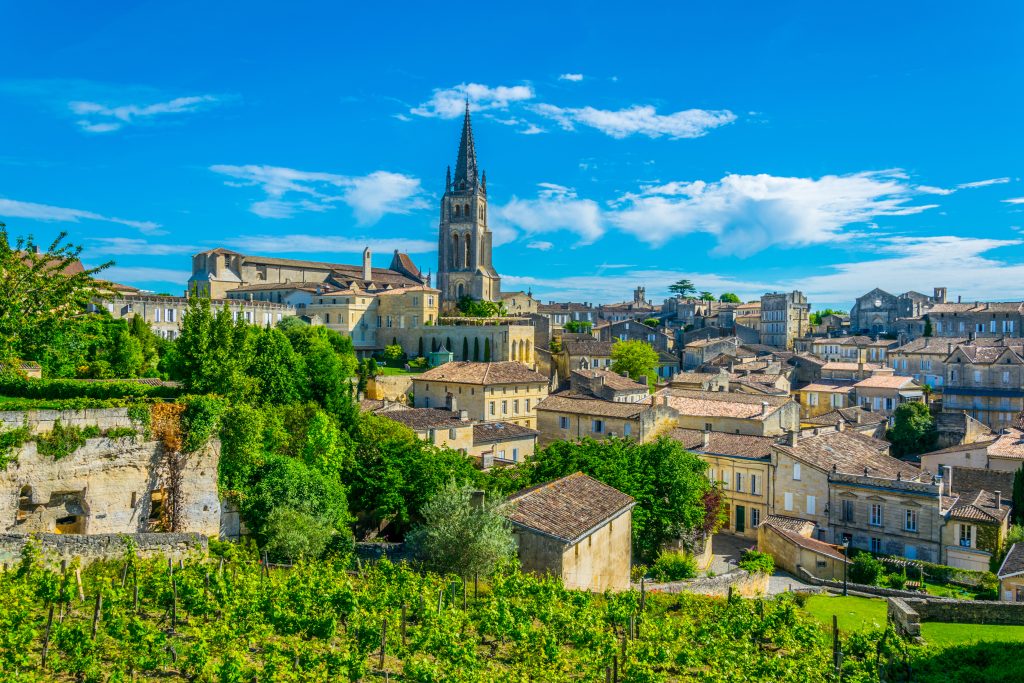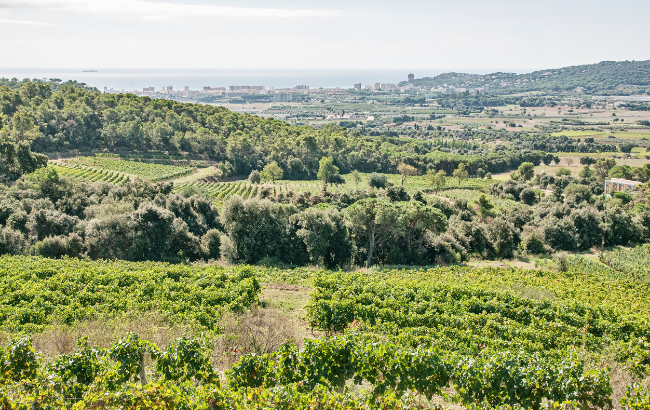Saint Émilion 2023: a vintage of glass ceilings
By Colin Haydb’s Bordeaux correspondent Colin Hay continues his appellation-by-appellation tour of Bordeaux with Saint Émilion. Despite finding more great wines than in any other appellation, he also finds a glass ceiling – with smaller, less affluent producers unable to withstand the endemic mildew presented by the vintage.

There is an almost inevitable moment in any en primeur week when the alarm rings especially early, one brushes the sleep from one’s eyes, crawls out of bed in search of coffee and races to the Rocade and the Pont d’Aquitaine to cross from the left-bank to the right-bank (or from the right to the left) – invariably for the earliest early morning appointment of the entire week.
After our quick tour northwards up the Gironde from Margaux, via St-Julien and Pauillac to St-Estèphe we’ve reached that point in our journey (though we’ll cross back again before we are finished). And, as you’ve probably already noticed, having chosen at the time rather innocently to travel northwards up the Médoc, our passage to the right-bank is, of course, rather longer than it needed to be.
So what is in store for us on the other side of the river once we get there – above all in Saint-Émilion, our first right-bank calling point?
The watch-word here is heterogeneity. And that is perhaps not surprising, even if this time last year I was writing about the surprising homogeneity of Saint-Émilion’s 2022s.
As I noted then, we tend to think of Saint-Émilion as having an almost natural tendency to heterogeneity for three reasons above all: first, its sheer size; second, the qualitative range and diversity of its terroirs and, crucially, their respective capacities to respond to the climatic conditions they face; and, third, its stylistic diversity.
In 2023 the first two of these factors, I would argue, were rather more important than the third. But they are joined by a fourth – the massively uneven access to the resources to cope with, and thereby to compensate for, the meteorological challenges posed by the growing season.
Saint-Émilion is, of course, a large appellation with over 4000 hectares of grand cru vineyards alone in 2023 (in comparison, say, to Margaux’s 1500 and Pomerol’s 780). It is also arrayed over a diversity of terroirs of rather variable quality. In a growing season in which even contiguous vineyards experienced significant differences in their exposure, above all, to mildew, this was always likely to produce considerable heterogeneity.
Crucial here were the relative size of the downpours that punctuated June and the extent to which they were book-ended by the spikes in temperature that helped propagate the mildew. In some vineyards, in short, the natural pressure of mildew was simply greater than in others, with limestone terroirs and Cabernet plots much more resistant than their sand and Merlot counterparts respectively.
The aggregate numbers (which are displayed in Table 1) capture little of this detail, even if they do show the significant accumulation of rainfall between budburst and the harvest (notably in June).
|
Pre-budburst (Nov-March) |
Budburst to Harvest (April-mid October) |
Total (1/11-15/10) |
|
| St-Emilion | 306 (-37.1%) | 490.8 (+18.1%) | 796.8 (-11.8%) |
| Margaux | 398 (-19.3%) | 464.6 (+11.0%) | 862.6 (-5.7%) |
| St Julien | 458 (-5.8%) | 441.3 (+13.3%) | 899.2 (+1.2%) |
| Pauillac | 458 (-5.8%) | 441.3 (+13.2%) | 899.2 (+1.2%) |
| St-Estèphe | 550.7 (+3.0%) | 411.8 (+4.7%) | 912.5 (+1.5%) |
| Pessac-Léognan | 426 (-12.4%) | 469.4 (+14.5%) | 895.2 (0%) |
| Pomerol | 338 (-31.5%) | 470.0 (+14.5%) | 808.1 (-10.9%) |
Table 1: Rainfall during the vintage (relative to 10-year average)
Source: calculated from Saturnalia’s Bordeaux 2023 Harvest report
But, in a way tragically, more important than any of this was the relative capacity of different properties to cope with whatever mildew pressure they faced. The flatter southern and western parts of the appellation, closer to the river, on more sandy soils suffered in some cases horrific losses. They did so not because the weather conditions were significantly worse, nor even really because their terroirs were more susceptible to mildew (though to some extent that was the case), but simply because, with a much lower average retail price per bottle, they did not have access to the financial and hence human resources required to treat effectively. Here mildew became endemic.
Compounding the tragedy, those parcels, plots and vineyards already weakened by mildew damage proved much more susceptible to the desiccation and burning of the fruit on the vines in the heatwave conditions established in the Indian Summer immediately preceding the harvest.
I tasted many wines from these parts of the appellation. But you will not find many of my tasting notes below. For, much though it pains me to say so and through no fault of their producers, many did not meet the qualitative threshold for inclusion in my appellation profile.
This is, in effect, the first glass ceiling in the 2023 vintage in Saint-Émilion. But it is not the only one.
Partner Content
Crucial then to the heterogeneity of Saint-Émilion in this vintage was the differential capacity to cope with the challenges that nature presented. It alone goes a long way to explaining why average vineyard yields in Saint-Émilion (as Table 2 shows) were so much lower (above all with respect to the 10-year average) than they were in Pomerol, despite an essentially similar meteorological experience.
| 2019 | 2020 | 2021 | 2022 | 2023 | 10-year average | Relative to 10-year average (% change) | |
| St Emilion (GC) | 43.0 | 36.7 | 27.5 | 41.2 | 40.5 | 37.2 | +8.9 |
| Margaux | 49.2 | 36.3 | 38.6 | 31.3 | 37.7 | 39.7 | -5.0 |
| St Julien | 45.5 | 34.3 | 35.2 | 34.3 | 50.3 | 40.1 | +25.4 |
| Pauillac | 46.7 | 37.4 | 35.1 | 34.8 | 47.1 | 39.7 | +18.6 |
| St Estèphe | 49.7 | 41.2 | 40.7 | 31.5 | 51.6 | 43.4 | +18.9 |
| Pessac-Léognan rouge | 47.2 | 34.6 | 30.7 | 35.7 | 38.1 | 38.5 | -1.0 |
| Pomerol | 43.0 | 39.8 | 28.9 | 32.3 | 45.2 | 36.1 | +25.2 |
Table 2: Average vineyard yield by appellation (hl/ha)
Source: calculated from Duanes data compiled by the CIVB Service Economie et Etudes
The wines themselves
Heterogeneity is the watch work for the 2023 vintage in Saint-Émilion. But it is not – and nor should not it be taken as – a synonym for the absence of quality. There are truly great wines to be found in Saint-Émilion in 2023. Indeed, and however paradoxical though it might at first seem, given the sheer size of the appellation and the relatively small size of the vineyards, it is in the end hardly surprising that there are more truly great wines here than there are in any other leading appellation.
There are at least 30 wines that I would love to have teleported to my cellar in 5 to 10 years’ time (admittedly, from over 150 tasted). That cannot be said for any other leading appellation.
But that is perhaps to soften the pill. For there are, in the end, a series of glass ceilings here beneath which the wines of the appellation seem to bunch and cluster. The first we have already dealt with – the quality threshold set by the presence of systemic mildew and its consequences in many vineyards.
But that is just the first of three. The second is the tendency of at least some of these wines, typically on lesser terroirs, to be lean and slender, slightly hollow in the mid-palate and abrasive on the finish due to the combination of coarse tannins and elevated acidity. The third arises simply from the qualitative diversity of Saint-Émilion’s terroirs, with the crystalline, limpid and luminous quality of the vintage combined with a return to a more classical style of wine-making revealing in some cases well-made wines lacking complexity and interest. Though my highest ratings are the same as those in 2022, my average rating for the grands crus classés is lower and the slope of their exponential decline is steeper.
At each and every one of these glass ceilings, and especially at the last, 2023 reveals itself to be a vintage of terroir quality and intense hard work. Where we have both, and the resources to make possible the latter, we have genuine excellence. But it is thinner on the ground and more unevenly distributed than it was in 2022.
There are for me two wines, above all, that transcend the challenges of the vintages and that shatter each and every glass ceiling with which we might associate those challenges. Both are magical expressions of their very different, unique and exceptional terroirs – Cheval Blanc and Beauséjour. I love them both and would hate to have to choose between them.
They pip at the post – but only by a hair’s breadth – two other transcendent wines that are certainly for me on a par with anything I have ever tasted from either property. They are Figeac and Rocheyron, once again the former from a predominantly clay and gravel terroir, the latter from a predominantly limestone and clay terroir.
It is perhaps hardly surprising that Ausone, Bélair-Monange, Angélus, Canon and Pavie have also produced wines of stunning brilliance once again, so let me perhaps single out for special mention five wines that have for me produced the best I have ever tasted from them in the context of the vintage. They are, in strictly alphabetical order: Beau-Séjour Bécot, Bellefont Belcier, Clos de Sarpe, Couvent des Jacobins and Lassègue.
And, in terms of the sheer value for money they offer, it is difficult to look beyond (again, in alphabetical order): Berliquet, Couvent des Jacobins (once again), Laroque, Lassègue (ditto) and Mangot.
Let me finish with a potentially interesting observation inspired by a reflection of a similar kind last year. In my appellation profile of the 2022 vintage, I identified 24, of which only 12 featured in the new classification of the wines of Saint-Émilion. This year I have identified 29 stars of the (2023) vintage, 21 of which feature in the same classification.
Highlights in 2023
Best of the appellation:
- Cheval Blanc (98-100)
- Beauséjour (98-100)
Truly great:
- Figeac (97-99)
- Rocheyron (97-99)
- Ausone (96-98+)
- Bélair-Monange (96-98+)
- Angélus (96-98)
- Beau-Séjour Bécot (96-98)
- Canon (96-98)
- Pavie (96-98)
Excellent:
- Clos Fourtet (95-97+)
- Croix de Labrie (95-97+)
- Larcis Ducasse (95-97+)
- Berliquet (95-97)
- L’If (95-97)
- La Mondotte (95-97)
- Troplong Mondot (95-97)
- Trottevieille (95-97)
- Valandraud (95-97)
- Bellefont Belcier (94-96+)
- Laroque (94-96+)
Value picks:
- Berliquet (95-97)
- Bellefont Belcier (94-96+)
- Laroque (94-96+)
- Calicem (94-96)
- Tour St-Christophe (93-95+)
- Couvent des Jacobins (93-95)
- La Dominique (93-95)
- L’Etampe (93-95)
- Fonplégade (93-95)
- Fleur de Lisse (93-95)
- Lassègue (93-95)
- Mangot (93-95)
Seehere for Colin’s full tasting notes for Saint Émilion and his appellation analysis for Margaux, St Julien, Pauillac, St Estèphe and Saint Émilion.
Read more:
A guide to Bordeaux 2023 in ten questions
Bordeaux 2023 vintage report part I: quality and quantity together, for once
Bordeaux vintage report part 2: a vintage of reactivity, vigilance and surveillance
Related news
How to make top blanc de blancs in 'the kingdom of Pinot Noir'




